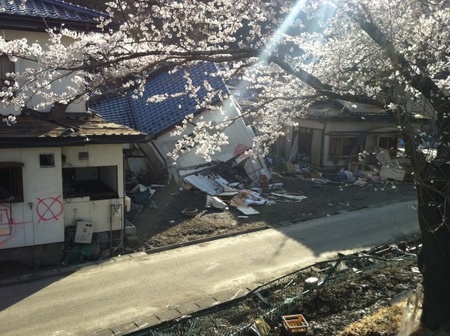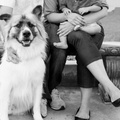Being that my mother is from Japan, I feel a connection to that country that many Japanese Americans do not. So when the earthquake/tsunami/nuclear disaster hit in March, I felt it in my gut. I was worried not only about my relatives but also friends and strangers alike. At home, I made it point to take another look at my family’s earthquake disaster plan and make sure we all knew what to do. However, after only seven months, life has returned to normal for me.
That’s why when when I watched The Tsunami and the Cherry Blossom, it brought back all of those memories and made me remember that much of Japan is still trying to recover. I got a chance to ask the Lucy Walker, an Academy Award nominated filmmaker, some questions about her very moving documentary.
What is the significance of the title, The Tsunami and the Cherry Blossom?
The title is really literal – because the film is truly about the tsunami and also about sakura, the Japanese word for cherry blossom. But I like the title because it sounds a bit like a fable, and in a way the film is very simple but profound like a fable. I actually had trouble picking between a couple of different titles, so I asked my friends on Facebook to help me choose, and the most popular title was this one. I think the simplicity is very helpful given the terribly emotional subject matter. I also liked Tsunami/Sakura, because that was even simpler, but I think it was a little less inviting, less story-like. I want people to be asking if there are any connections between such different things.
What drew you to this project?
I have always loved cherry blossom, from when I was a young girl gazing at the blossoms in the backyards in England where I grew up. When I first got into photography my first projects were taking pictures of blossom – they are very encouraging because it’s easy to take great photos. Later I learned that Japanese people were as fascinated I was, and it was always my ambition to lay under blossoming trees and talk and drink with friends and reflect on the transience of life. At New Year this year when I was feeling very burned-out I suddenly got the idea to make a short film about blossom – like a visual haiku. Then the earthquake, tsunami, and nuclear disaster happened on March 11th, and my first thought was that I couldn’t do this now. Then I immediately thought it was a more important time than ever to celebrate Japanese culture and help Japanese people, to show our solidarity and appreciation.
One of the most moving (and disturbing) parts of the film was the footage of the tsunami. Where did you find the footage?
Our wonderful editor Aki Mizutani found that. There are a lot of very sad, powerful images of the tsunami but somehow this one got me the most. I knew immediately that it would be the best way to show the audience what actually happened, without cutting away, leaving the shot very long so they could really experience quite how unimaginable the destruction was. In the shot you see the whole town before, and the whole town swallowed, all the way up to the tsunami swallowing the people right in front of your eyes. It’s the most shocking piece and we were very lucky that the person who filmed it kindly allowed us to use it.
How are the people you interviewed in the film doing today? Do you keep in touch?
We had a wonderful guy-on-the-ground named James MacWhyte – he was our combination production manager, interpreter, and local guide. He lives in Tokyo (although he grew up in Seattle) and he’s our in-touch person. I’d like to be in touch more myself but the language barrier can be difficult as alas I can’t speak Japanese. I know that the area is still very devastated and people are struggling and need as much support as possible, especially now that the winter is coming again. If you Google search you can see some images for some of the areas we filmed such as Kessenuma. The areas around the nuclear plant are especially challenging to clean up because of the radiation, and I worry most about the people who lived or are living near there. It is very, very sad, but as the film shows I hope, the people are amazingly resilient and strong and impressive. I could never imagine people rising to such challenges so beautifully as the people I met this spring in Japan.
How can people watch the film?
The film is playing at Laemmle’s Falllbrook on the big screen every evening right now! Then we are trying to work out beyond that how we will show it — please check out our website for details at thetsunamiandthecherryblossom.com — we also have details about how people can donate to help the victims, and especially the children who were orphaned.
Lucy Walker is best known for directing four feature documentaries: DEVIL’S PLAYGROUND (2002), BLINDSIGHT (2006), WASTE LAND (2010) and COUNTDOWN TO ZERO (2010). COUNTDOWN TO ZERO, a terrifying exposé of the threat of nuclear terrorism and proliferation, premiered at Sundance and screened in the Cannes Official Selection. WASTE LAND is the story of Brazilian artist Vik Muniz and a lively group of catadores, or scavengers, who find a way from the world’s largest garbage dump in Rio to the most prestigious auction house in London. It is the first film to win the Audience Awards at Sundance and Berlin, as well as at Full Frame and Seattle. Walker is also the first filmmaker to have won the Berlin Award twice, including the audience award for BLINDSIGHT. The film received , nominated for Best Documentary Grierson Awards, British Independent Film Awards; and short-listed for the Academy Award. BLINDSIGHT follows the ill-fated journey of six blind Tibetan teenagers climbing Everest. DEVIL’S PLAYGROUND, which premiered at Sundance 2002, examined the struggles of Amish teenagers during their rumspringa. It won multiple festival awards, three Emmy nominations and an Independent Spirit nomination. Walker grew up in London, England. After directing theater and graduating from Oxford University with First Class Honors in Literature she won a Fulbright to attend NYU’s Graduate Film Program, where she earned her MFA, directed short fiction films, and moonlighted as a musician.
* This article was originally published on 8Asians.com on October 12, 2011.
© 2011 Koji Steven Sakai








